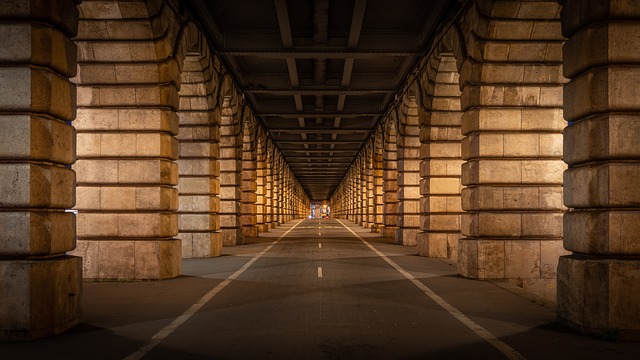Mosques in Karachi's Muslimabad Society are cultural and religious landmarks, showcasing South Asia's Islamic art evolution through diverse historical structures. These architectural marvels serve as community hubs, preserving local heritage while facilitating social interaction, education, and charity. As traditional institutions, they adapt to the digital age by embracing technology while maintaining core values, engaging younger generations with innovative online solutions for prayer and education, thereby ensuring the relevance of Islamic practices in Karachi's diverse communities.
“Exploring the Heart of Karachi’s Muslimabad: The Mosques’ Evolution and Impact
This article delves into the rich history and architectural splendor of mosques in Karachi’s Muslimabad Society. From their historical background as centers of community and cultural significance, to their modern adaptations in the digital age, we uncover the key role they play in social development. Discover how these architectural wonders continue to foster engagement and face challenges, shaping the fabric of Karachi’s diverse landscape.”
- Historical Background of Mosques in Karachi's Muslimabad Society
- Architectural Wonders and Their Cultural Significance
- Community Engagement and Role in Social Development
- Challenges and Modern Adaptations in the Digital Age
Historical Background of Mosques in Karachi's Muslimabad Society

Mosques have been an integral part of Karachi’s Muslimabad Society for centuries, reflecting the rich cultural and religious heritage of the region. The city, known for its vibrant diversity, boasts a multitude of historical mosques that serve as both places of worship and architectural marvels. These structures not only hold immense spiritual significance but also stand as testaments to the evolution of Islamic art and design in South Asia.
Karachi’s Muslimabad Society has witnessed the construction of various mosques over time, each leaving its mark on the city’s landscape. From ancient structures with intricate carvings to modern masterpieces incorporating contemporary design elements, these houses of prayer showcase the community’s deep-rooted faith and architectural prowess. The development of mosques in Karachi mirrors the societal changes and cultural influences that have shaped the city, making them valuable historical artifacts and focal points for the Muslim community.
Architectural Wonders and Their Cultural Significance

Karachi, as a vibrant metropolis, boasts some architectural marvels in its tapestry, with mosques playing a pivotal role in this cultural landscape. These structures are not just places of worship; they are living testaments to the rich history and artistic prowess of the Muslim community in the city. The intricate designs and grand facades of Karachi’s mosques reflect a synthesis of traditional Islamic architecture and local influences, creating a unique visual identity.
Each mosque tells a story, often mirroring the era during which it was built. From ancient masterpieces to modern interpretations, these architectural wonders foster a sense of community and spiritual connection. They serve as centres for cultural activities, gatherings, and celebrations, becoming integral parts of Karachi’s social fabric. The intricate craftsmanship and symbolism in their construction offer insights into the values and beliefs of the Muslimabad Society, making them valuable cultural heritage sites.
Community Engagement and Role in Social Development

Mosques in Karachi play a pivotal role in fostering community engagement and driving social development. They serve as vibrant centers where people from diverse backgrounds gather, not just for prayer but also for education, cultural events, and charitable initiatives. These institutions often organize programs focused on literacy, health awareness, and skill development, empowering local communities with knowledge and opportunities.
The social impact extends beyond the four walls of the mosque. Many mosques in Karachi actively participate in urban renewal projects, community clean-up drives, and disaster relief efforts. They act as catalysts for social cohesion by bringing people together, fostering understanding, and promoting a sense of shared responsibility within the neighborhood. This engagement not only strengthens the bond between residents but also contributes to the overall well-being and development of Karachi’s diverse communities.
Challenges and Modern Adaptations in the Digital Age

In the digital age, Karachi’s Muslimabad Society, like many traditional institutions, faces new challenges. The rapid evolution of technology has changed how communities connect and interact, demanding adaptable approaches from religious spaces. Mosques in particular need to embrace modern tools while preserving their core values. Digital platforms can be leveraged to expand reach, engage younger generations, and share Islamic knowledge more effectively.
However, these adaptations require careful consideration. Balancing the preservation of cultural identity with modernization is crucial. Innovative solutions, such as live-streaming prayers or online educational programs, must respect the spiritual needs and customs of the community while appealing to a contemporary audience in Karachi and beyond. This delicate equilibrium ensures that Islamic practices remain relevant and accessible in an ever-changing digital landscape.
The mosques of Karachi’s Muslimabad Society stand as architectural marvels, deeply intertwined with the cultural fabric of the city. Throughout history, these places of worship have not only served as spiritual centers but also as catalysts for social development and community engagement. In the digital age, while challenges emerge, mosques adapt to modern times, leveraging technology to strengthen their role in Karachi’s diverse landscape. Their resilience and ability to evolve ensure that they remain vibrant hubs, connecting past, present, and future generations of Muslims in the bustling metropolis.
